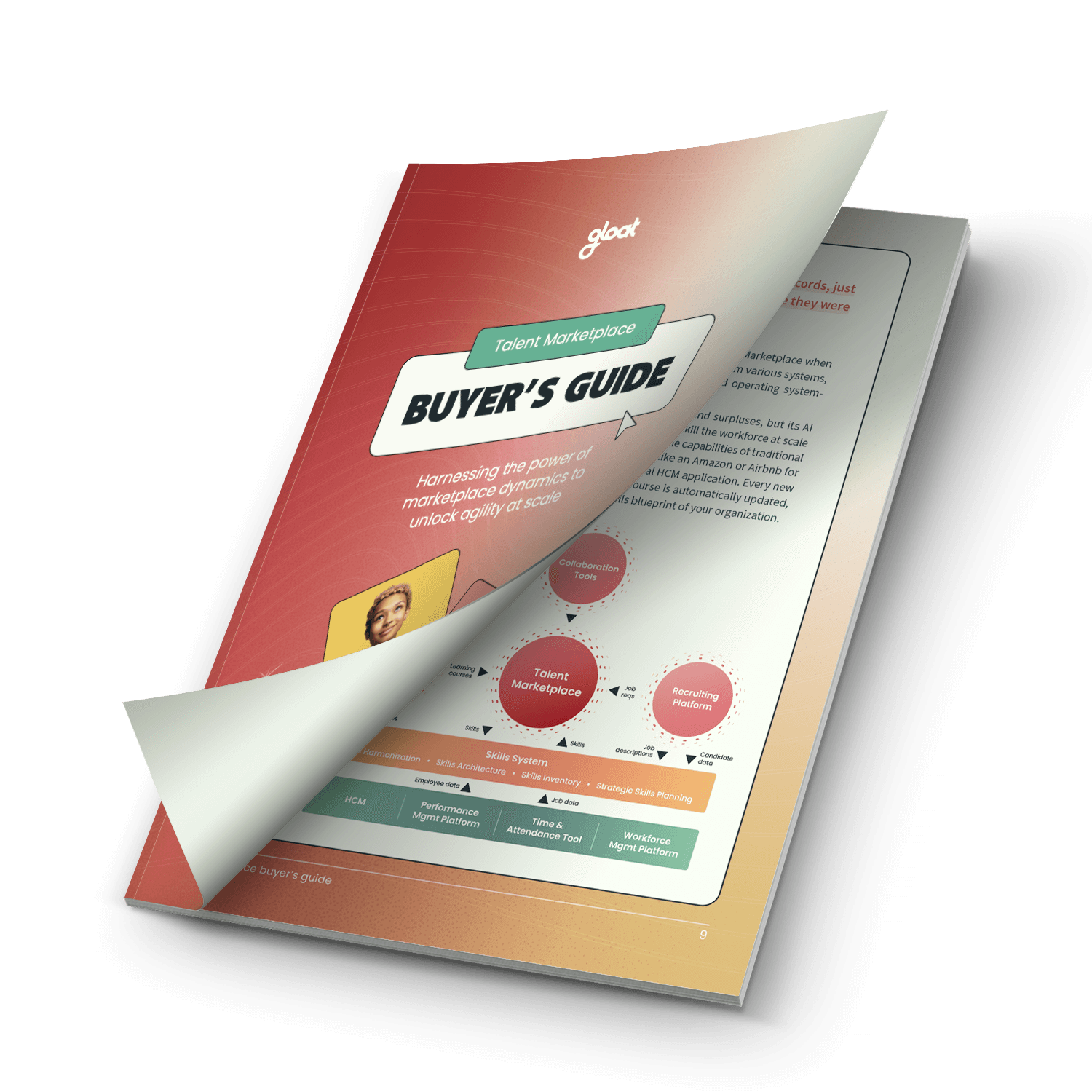What is internal mobility and why do you need it?
Why internal mobility programs make all the difference.

Just a few years ago, stories about employees taking on new roles internally within their organizations were few and far between. For the most part, people were expected to stick with what they were hired to do, even once they outgrew it or started getting curious about new areas of the business.
But as talent shortages grow more severe and consumer expectations shift, HR leaders can no longer rely solely on external hiring to fill vacancies and bridge skill gaps. Instead, savvy executives are turning their attention inwards and creating learning and development pathways to empower their existing workforce to build the skills the future of work demands.
Particularly as the rapid proliferation of AI promises to shift job and skill needs, HR leaders must ensure their people have the tools and systems needed to hone new expertise to move into emerging roles. Rather than focusing on external hiring, leaders are now prioritizing internal mobility and empowering their people to take on new responsibilities within their organizations.
What is internal mobility?
Internal mobility is the movement of employees (both vertically and horizontally) to new career and development opportunities within the same company. Some examples of internal mobility include promotions, new positions, mentorships, cross-functional projects, job shadowing, and job swaps.
Internal mobility is also known as career mobility or talent mobility. Whatever you want to call it, the foundation remains the same: giving your talent the ability to pursue a broader range of opportunities to not only create more capable and engaged employees but also a more resilient organization. The best internal mobility strategies encourage people to take on new growth opportunities that align with the employee’s long-term career goals and business priorities.
Why is internal mobility important?
Internal mobility has always been a cost-effective talent strategy, but it’s quickly becoming non-negotiable in our new world of work. Now that 77% of employers are finding it difficult to fill job vacancies, it’s becoming increasingly clear that relying solely on external hiring won’t be feasible as labor shortages continue.
Instead of looking to new talent for the skills your business needs, leaders must begin developing these capabilities internally. Ultimately, internal mobility will become a win-win because your people will benefit from learning new skills and moving into roles they’re passionate about, which will in turn have a positive impact on how your business performs.
6 benefits of internal mobility
Organizations that prioritize internal mobility enjoy a multitude of business-wide advantages, including:
#1. Attract and retain top talent
No employee wants their career paths to be stagnant. Your people value the opportunity to learn new things and take on new challenges. In fact, a recent LinkedIn report found that 94% of workers say they would stay at a company longer if it invested in their careers. An internal mobility strategy shows that you’re serious about employee growth and that you have the systems and structures in place to help people achieve their professional ambitions.
#2. Promote knowledge sharing
When employees are encouraged to move into new roles within their organization, they take the knowledge they’ve learned with them. As more workers take on new opportunities on different teams, they will be able to freely share the expertise they’ve acquired from past positions with colleagues whom they may not have had the chance to collaborate with before.
#3. Save time and money
Even if you recruit all-star candidates, hiring new employees is going to be expensive and time-consuming. It’s estimated that large enterprise organizations lose more than $400,000 annually from the costs involved in recruiting and training new hires. With internal mobility, you don’t have to pay the sticker price to get your hands on the talent you need. Instead, you can minimize onboarding processes by leveraging employees who already know how your business works, making it easy for them to get up to speed.
#4. Increased workplace diversity
When companies take a skills-based approach to internal mobility in which employees are empowered to move into new roles based on their capabilities, leaders can feel confident that they’re making strides to promote workforce diversity. Rather than relying on potentially bias-inducing factors when making career development decisions, companies are turning to talent marketplaces to match employees to open opportunities based on their skills and interests. These platforms remove barriers that may have once held employees from underrepresented groups back, in turn leveling the playing field for your workforce.
#5. Fill skill gaps
Unfortunately, the number of organizations working with skill gaps is heading in the wrong direction. 69% of HR leaders currently report that their organizations are struggling with talent shortages, up from 55% the year prior. Rather than letting knowledge gaps grow, leading organizations launch internal mobility programs so employees can hone new skills by participating in projects and assignments. These cross-functional opportunities allow the workforce to develop new capabilities and prevent the business from falling victim to institutional knowledge loss.
#6. Break down silos
When employees don’t have the chance to pitch in on projects for other parts of the organization, their unique skills and institutional knowledge can only be used by the team they’re on. Rather than keeping their expertise trapped within a specific department, companies that prioritize internal mobility enable their workforce to share their skills with colleagues in different functions so that employees can learn from one another.
5 examples of internal mobility
#1. Promotions
When a more senior position such as a manager or team lead becomes available in a company, that role can be filled by someone from the existing talent pool. Climbing the corporate ladder is probably what comes to mind when many people think of internal mobility, but it’s just one among several other examples.
#2. Intradepartmental and interdepartmental transfers
Intradepartmental transfers are when an employee is moved to a different role within the same department. In contrast, interdepartmental transfers occur when an employee is moved from one department to another.
#3. New roles
Regardless of their size, most businesses create new roles to meet evolving demands. These positions can be filled by the most skilled and best-suited person within the company.
#4. Mentorships
Employees can move around to learn from their colleagues in other departments. This could be to help upskill an employee for a promotion or to expand their understanding of another role or area of the business.
#5. Projects and gigs
Employees have the opportunity to work on part-time assignments to develop new skills and enhance cross-functional collaboration. Project and gig work can help companies respond rapidly to emerging needs by reallocating talent from across the organization.
5 types of internal mobility programs
There are many different ways that leaders can harness internal mobility to help their organization unlock agility. Five types of internal mobility programs include:
#1. Role-to-role mobility
Role-to-role mobility, also known as lateral mobility, describes a job change in which individuals move internally from one position to another with little change in their salary or level. Although employees aren’t moving vertically on the traditional career ladder, that doesn’t mean that role-to-role mobility isn’t beneficial. It allows workers to apply the skills they’ve acquired in their current role to other areas of the business, in turn, fueling more effective cross-functional collaboration and knowledge-sharing.
#2. Transfers
In contrast to role-to-role mobility, transfers occur when employees keep the same responsibilities and compensation but change their physical location. Transfers can be permanent, temporary, or ad-hoc and typically take place to meet business priorities or employee preferences.
#3. Upward mobility
Upward mobility is what employees generally think of as a promotion. It means that a worker advances to a higher job class or function within the same department because of their excellent performance. Upward mobility is a powerful way to keep employee satisfaction and engagement high while boosting morale and productivity. Promoting employees from within your own organization sends a positive signal to their colleagues that their efforts will be rewarded and demonstrates that your organization values internal mobility.
#4. Project-based mobility
Project-based mobility allows employees to collaborate with colleagues they may not normally work with. Team members from different departments come together to achieve a common business goal or complete a specific, one-off project by leveraging a diverse set of functional expertise. Project-based mobility enables employees to dedicate part of their work to projects beyond their usual workflow and department.
#5. Internal mobility platforms
Internal mobility platforms, also known as talent marketplaces, are new technological innovations that are designed to facilitate all forms of career movement and project-based work. Talent marketplaces are one of the most impactful technologies for internal mobility, as these platforms match employees to open opportunities based on the skills they possess and the knowledge they wish to hone.
3 steps to enable internal mobility at your organization
There are three key steps leaders can take to encourage their organization to embrace internal mobility.
#1. Embrace role-to-role mobility
It’s going to be impossible to encourage internal mobility if your managers are stuck in a talent-hoarding mentality. While it’s natural to be possessive of top performers, leaders need to encourage line managers to embrace internal mobility as a means to broaden the talent pools available to them. By creating a more fluid talent movement between departments, managers will have access to even more qualified candidates capable of handling a greater variety of tasks—far more so than a siloed workforce could offer.
#2. Utilize internal transfers for experiential learning opportunities
If you want internal mobility to take off, you need to make sure employees have the support they need to learn new skills. While L&D content is certainly a step in the right direction, your people also need the chance to put these lessons into practice through hands-on growth opportunities like projects, gigs, and mentorships. Talent marketplaces allow talent to seamlessly transfer into new short-term projects based on an employee’s skills and ambitions, fostering a company-wide internal growth mindset and shoring up skill gaps as business needs evolve.
#3. Make upward mobility a reality through career ownership
While all of your employees want to grow their careers, the goals they have are going to look very different from their colleagues. Instead of taking a one-size-fits-all approach and telling your people what direction they should take—up in their current trajectory, or even laterally to a new department —put them in the driver’s seat of their own development. When employees are at the helm of their careers, they will be more engaged in the learning experiences they are participating in, ultimately leading to superior results for your initiative.
Why talent marketplaces are essential for project-based mobility
In the past, a lack of transparency meant that most internal mobility initiatives were doomed to fail. Leaders couldn’t see their people’s skills, interests, and ambitions, and employees didn’t have visibility into the opportunities within their organization. There was no way to match people to roles or align employee goals with the needs of the business.
The rise of talent marketplaces is here to change all of that. The platforms harness the power of AI to generate relevant suggestions for opportunities that employees will want to get involved in. The newest offerings even give workers a view into their long-term growth potential by showcasing several different directions their careers can take. To learn more about these game-changing platforms and uncover the factors you need to weigh when deciding which one to implement, check out our Talent Marketplace Buyer’s Guide.






